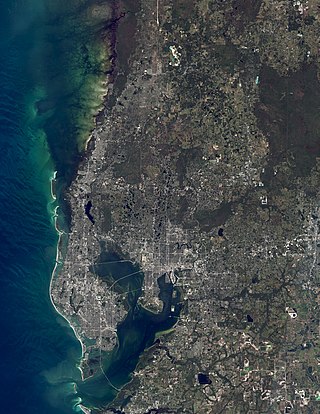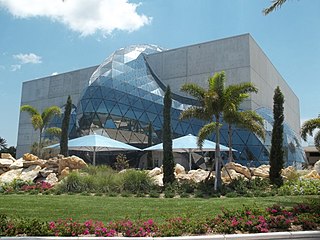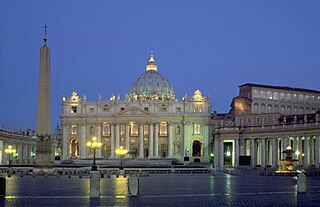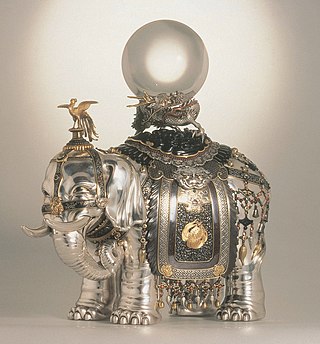
Dale Chihuly is an American glass artist and entrepreneur. He is well known in the field of blown glass, "moving it into the realm of large-scale sculpture".

St. Petersburg is a city in Pinellas County, Florida, United States. As of the 2020 census, the population was 258,308, making it the fifth-most populous city in Florida and the second-largest city in the Tampa Bay Area, after Tampa. It is the largest city in the state that is not a county seat. Along with Clearwater, these cities are part of the Tampa–St. Petersburg–Clearwater Metropolitan Statistical Area, the second-largest in Florida with a population of around 2.8 million. St. Petersburg is on the Pinellas peninsula between Tampa Bay and the Gulf of Mexico, and is connected to mainland Florida to the north.

The Tampa Bay area is a major metropolitan area surrounding Tampa Bay on the Gulf Coast of Florida in the United States. It includes the main cities of Tampa, St. Petersburg, and Clearwater. It is the 17th-largest metropolitan area in the United States, with a population of 3,175,275 as of the 2020 U.S. Census.
Soviet nonconformist art was Soviet art produced in the former Soviet Union outside the control of the Soviet state started in the Stalinist era, in particular, outside of the rubric of Socialist Realism. Other terms used to refer to this phenomenon are Soviet counterculture, "underground art" or "unofficial art".

David Vincent Hayes was an American sculptor.

The Salvador Dalí Museum is an art museum in St. Petersburg, Florida, United States, dedicated to the works of Salvador Dalí. Designed by Yann Weymouth, the museum is located on the downtown St. Petersburg waterfront by 5th Avenue Southeast, Bay Shore Drive, and Dan Wheldon Way.
Maas Brothers was a leading Tampa, Florida department store founded by Abe and Isaac Maas in 1886 that grew from a small 23-by-90-foot store to a chain of 39 stores throughout the Gulf Coast of Florida. The Maas Brothers brand went defunct in 1991 when it was consolidated into the Burdines department store chain, which in turn merged with Macy's in 2005.
The Gulf Coast Museum of Art was located at 12211 Walsingham Road, Largo, Florida. It housed contemporary Florida art in the permanent collection.
Peter Sarkisian is an American new media artist based in Santa Fe, New Mexico. He combines video projection and sculpture to create hybrid-format, multi-media installations.

Tampa Bay History Center is a history museum in Tampa, Florida. It is a Smithsonian Affiliate and has been accredited by the American Alliance of Museums since 2015. Exhibits include coverage of the Tampa Bay area's first native inhabitants, Spanish conquistadors, and historical figures who shaped the area's history, as well as a reproduction of a 1920s cigar store. The museum is on the waterfront at 801 Water Street in Tampa's Channelside District. It opened on January 17, 2009. The History Center building is 60,000 square feet (5,600 m2) with 25,000 square feet (2,300 m2) of exhibit space.

Vatican Splendors: A Journey Through Faith and Art is a touring exhibit of religious and historical objects from the Vatican, some of them nearly two thousand years old. In 2010-11, the exhibit toured six cities in the U.S.: Cleveland, St. Paul, St. Petersburg, St. Louis, Pittsburgh, and Fort Lauderdale, and continued to São Paulo, Brazil.

Ando Jubei (1876–1956) was a Japanese cloisonné artist from Nagoya. Along with Hayashi Kodenji, he dominated Nagoya's enameling industry in the late Meiji era. Ando, Namikawa Yasuyuki, and Namikawa Sōsuke are considered the three artists whose technical innovations brought in the "Golden Age for Japanese cloisonné" in the late 19th century.

Ray L. Burggraf is an artist, color theorist, and Emeritus Professor of Fine Arts at Florida State University. According to Roald Nasgaard, Burggraf's paintings exhibit "visual excitation...pulsating patterns, vibrating after-images, weird illusionistic spaces, multifocal opticality, executed with knife-edge precision...crisp and elegant and radiant with light." From a historical perspective, Burggraf's work is "nature evocative...reach[ing] back to the modernist landscape tradition of the Impressionists and of Neo-impressionists like Seurat, who, in the late-nineteenth century immersed themselves in the color theories of Chevreul and Rood".
Lorenzo Scott was born in 1934 in West Point, Georgia. Scott is a contemporary American artist whose work gained prominence in the late 1980s.

Carol Brown Goldberg is an American artist working in a variety of media. While primarily a painter creating heavily detailed work as large as 10 feet by 10 feet, she is also known for sculpture, film, and drawing. Her work has ranged from narrative genre paintings to multi-layered abstractions to realistic portraits to intricate gardens and jungles.

Gary Russell Libby is an American art historian, author, educator and former museum director known for his books and scholarly exhibitions in the visual arts and his work on the history and development of the Florida School of Art.

The Khalili Collection of Japanese Art is a private collection of decorative art from Meiji-era (1868–1912) Japan, assembled by the British-Iranian scholar, collector and philanthropist Nasser D. Khalili. Its 1,400 art works include metalwork, enamels, ceramics, lacquered objects, and textile art, making it comparable only to the collection of the Japanese imperial family in terms of size and quality. The Meiji era was a time when Japan absorbed some Western cultural influences and used international events to promote its art, which became very influential in Europe. Rather than covering the whole range of Meiji-era decorative art, Khalili has focused on objects of the highest technical and artistic quality. Some of the works were made by artists of the imperial court for the Great Exhibitions of the late 19th century. The collection is one of eight assembled, published, and exhibited by Khalili.

The Khalili Imperial Garniture is a trio of cloisonné vases created for a Japanese Imperial commission during the Meiji era. The items were exhibited at the World's Columbian Exposition in Chicago, United States, in 1893, where they were described as "the largest examples of cloisonné enamel ever made". The decoration of the vases represents virtues and the seasons, and also has an allegorical meaning about Japan's role in a changing world and its alliance with the United States. After being exhibited, the vases were separated from each other for more than 120 years, eventually reunited in 2019 in the Khalili Collection of Japanese Art, a private collection assembled by the British-Iranian collector and scholar Nasser D. Khalili.
Yabu Meizan was a Japanese artist and workshop owner known for painting on porcelain. His studio produced high-end Satsuma ware, primarily for the export market. That term was originally coined for artistic painted porcelain from the Satsuma Province. Eventually it expanded to include low-quality porcelain that was mass-produced for export, whereas Meizan was one of the artists who continued the tradition of high artistic quality while also successfully exporting. He is regarded as the "prince" of this medium and today his works are sought after by collectors.














